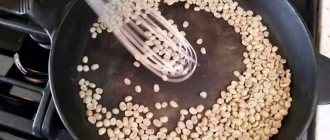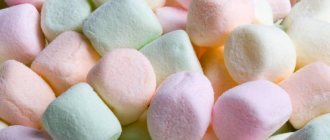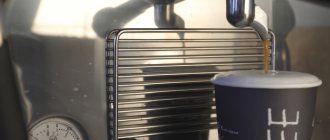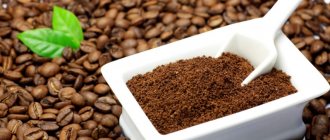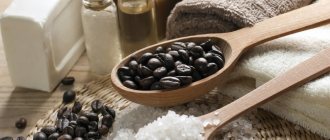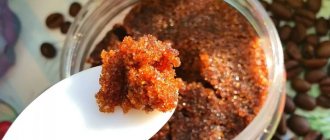Types of grinding coffee beans
The taste and aroma of the finished coffee largely depends on proper grinding.
The roasted beans are ground into particles of a size suitable for the specific method of preparing the drink. At home, achieving perfect coffee grinding is more difficult than using special equipment or a coffee grinder, but the drink does not lose its taste characteristics and gives the aroma of real coffee. Types of grinding:
- Large/rough. The size of the ground particles reaches 1 mm. Suitable for preparation in a French press, coffee pot, vacuum coffee maker, since large particles reveal the aroma well and do not end up in the cup. To obtain large fractions without a coffee grinder, use a food processor or blender.
- Average. A simple option for grinding coffee beans without a coffee grinder to a medium grind is manual application with a hammer, mortar, or knife. Medium fractions reveal flavor well in drip coffee makers.
- Thin. Small fractions of coffee beans are used for preparation in a Turk; espresso is brewed from them, aromatic drinks are brewed in geyser coffee makers and coffee machines. You can grind the beans until finely ground using a rolling pin and mortar and pestle, without using a coffee grinder.
- Extra-thin. Grinding the beans to a powder is suitable for making delicious Greek or Turkish coffee. Coffee grounds give the drink a special taste; you can use a mortar and pestle to grind it.
True gourmets will not refuse a cup of aromatic drink, even when there is no coffee grinder at hand. The fineness of the grind directly affects the strength and taste. For example, coffee powder produces rich, thick espresso. The beans, ground to a medium fraction, are suitable for making various drinks, including lattes.
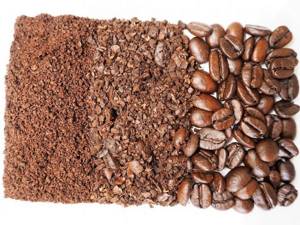
Grinder grain crusher
Many households have hand saws with rotating blades that are no longer needed. A grain crusher made from a grinder can be a good option for saw attachment. In addition to the saw itself, the following spare parts for grain crushers are needed:
- A piece of pipe with a diameter of at least 15 cm,
- Fine-section grating or mesh,
- Cutting discs (can be used from a meat grinder),
- Grain box,
- Sheet of plywood or laminate.
A do-it-yourself grain crusher from a grinder is made like this: the chainsaw body is mounted on a plywood sheet, in which small holes for fastening are pre-cut. An additional slot is made on the sheet and under the box or jar into which the crushed grain will be poured. Secure the chainsaw with metal brackets and bolts. A homemade crusher must be equipped with a sharp metal knife, sharpened on both sides. A mesh or sieve is attached to the bottom of the plywood sheet; you can also use homemade items from a saucepan. In this model, the engine for the grain crusher is the engine of an electric saw. DIY kruporushka is ready!
Crusher from washing machine
A do-it-yourself grain crusher made from a washing machine is also very popular among farmers.
The body of the washing machine is a ready-made powerful feed cutter. This type of grain crusher works on a principle similar to a coffee grinder: the grains are crushed in a drum by rotating sharp knives in different directions. You can make this model with the following spare parts for grain crushers:
- Cutting discs or knives,
- Lattice,
- Additional engine,
- Metal corner or narrow plates,
- Hammer,
- A small piece of metal pipe.
Before making a crusher from a washing machine, you need to sharpen the knives or cutting discs used well. The knives are mounted on the shaft, and the shaft is then attached to the activator pulley with a washer.
The drain hole is increased in size using a hammer to a diameter of 12.5 cm. A piece of pipe is inserted into the resulting hole. The crushed grain will be poured along it into a box or box. A grid with small cells is installed in the tank of the machine at an angle of 13-17 degrees.
Read also: Corrosion-resistant steels and alloys
Mandatory condition: the size of the grill must completely match the dimensions of the internal tank.
Better grinding will help you get an additional engine for the grain crusher. It is installed under the cover, and a corner or metal plates are used for fastening. Another knife is placed on the motor shaft, the diameter of which is smaller than the size of the tank. It is advisable to cover the additional motor for the grain crusher with a casing. This will prevent dust and food particles from getting inside.
A self-made grain crusher will not be inferior in its capabilities and features to products sold on the construction market. The main component is the electric motor itself, which has a fairly high power and rotation speed. It is for this reason that models that are created from parts of a washing machine or from an angle grinder are very popular. Such self-created structures are considered indispensable in the household.
Using various kitchen appliances
There are enough utensils in the kitchen that are suitable for grinding coffee beans into fractions of the desired size. If you don't have a coffee grinder, you can use:
- Food processor.
- Blender.
- Meat grinder.
The grinding process takes a little time, the coffee is crushed into uneven large fractions. When using a meat grinder, both manual and electric models are suitable to grind coffee beans quickly and accurately.
Important! When grinding with a food processor, the grains are ground in short pulses of five seconds, after pouring the grains into a container. After grinding, the processor must be immediately disassembled and washed so that it does not retain the coffee aroma.
Blender
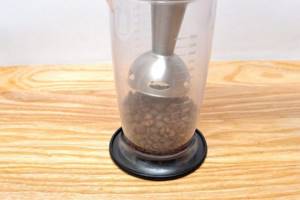
A blender is best for grinding fairly hard beans, especially if you need to get coarse coffee. To prevent the unit from overheating, the device is started in short pulses. How to grind coffee using a blender if you don’t have a coffee grinder:
- pour 100 grams of grains into a container;
- set the grinding option on the blender;
- grind at intervals of a couple of seconds;
- add more grain if necessary;
- repeat the grinding process.
When enough coarse coffee has been prepared, the product is poured out of the container, the blender is disassembled and immediately washed thoroughly. This helps eliminate the aroma of the roasted beans.
Important. When using an immersion blender for grinding, the grains are placed in a narrow container, and the hole is covered with your hand so that the grains do not “jump out”. Grind the product pulsed at intervals of 10 seconds.
Meat grinder
There is an electric or mechanical meat grinder in every home. It can be easily adapted for grinding coffee at home. The meat grinder needs to be disassembled and washed well so that the coffee beans do not absorb the odors of other products. If the set includes a special knife for grinding spices, you will get medium grinding fractions.
The required amount of grains is poured into the hole of the meat grinder and ground until uniform fractions are formed. Each repeated grinding makes the particles even smaller. The finished product is suitable for preparing the drink in French presses, coffee makers, Turks, and teapots.
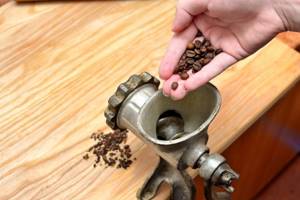
Manual grinding
It happens that there is no suitable kitchen equipment to grind coffee without a coffee grinder. Proven methods of manual grinding using kitchen utensils and ordinary household appliances come to the rescue. Such grinding does not take much time and effort - to grind coffee beans without a coffee grinder, you need to spend a few minutes, and you can enjoy the taste of your favorite drink.
Mechanical mill
Many housewives have such a simple device in their kitchen as a spice grinder. It can easily grind coffee beans to a medium grind fraction. Fine powder will not work, nor will large portions of coffee, but you can prepare the beans immediately before brewing the drink.
The grains are poured into the mill and the millstones are turned using a handle or a lid - depending on the design. From the first grinding, large fractions are obtained, after repeated grinding - raw materials that are suitable for brewing coffee, for example, in a Turk.
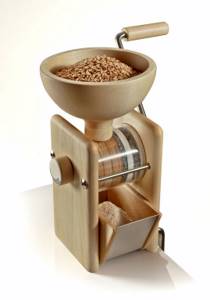
Hammer
An alternative method for hand grinding is to crush the beans with a hammer. The more intense the grinding, the finer the fraction of the prepared product. A chopping hammer, regular hammer or mallet is suitable. How to grind coffee:
- The grains are poured onto parchment paper or into a bag.
- The table is covered with a towel and wrapped beans are placed.
- The grains are “crushed” with uniform blows of the hammer.
The result is finished raw material of large or medium fraction. Suitable for brewing or steaming. To obtain a fine powder, repeat the manipulations several times. The grains should be laid out in a thin, even layer - this makes it easier to chop the beans.
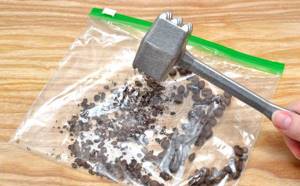
In a mortar
A simple method of grinding is to use a mortar and pestle. The old-fashioned method requires some effort, since the beans will have to be crushed into fine crumbs. But the time spent is worth it - the grains can be crushed to any fraction.
Pour a small portion of beans into a mortar. Using a pestle, the coffee is first crushed, then crushed to the desired fraction, and vigorously crushed in a mortar. You don't need to add a lot of beans to get a smooth grind.
Rolling pin
If it is not possible to use a coffee grinder to grind coffee, a regular rolling pin will do. With its help, raw materials of medium and fine grinding are obtained. You don't need anything other than a rolling pin and a freezer bag. How to grind grains:
- pour a small amount of beans into the bag;
- place on a flat surface - table, board;
- spread the coffee beans in an even layer;
- press down with a rolling pin to break up hard beans;
- crush the raw materials to the desired grinding fraction.
On a note. You can use a large carving knife instead of a rolling pin. The grains are placed on a hard surface, pressed flat with a knife and crushed into large crumbs.
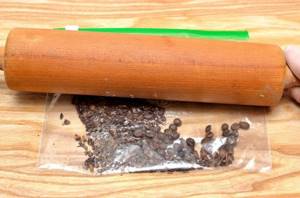
other methods
Hammer
You can grind coffee using a hammer. This simple grinding option produces medium-sized particles in a couple of minutes. Use a hammer or meat chop tool.
Be careful not to knock your fingers off. Use a hammer only as a last resort.
Wrap the coffee beans in a piece of paper or a thick bag to prevent them from flying around. Tap the raw material firmly with a hammer. To complete grinding you will have to spend 5-7 minutes.
The result will be a medium grind powder.
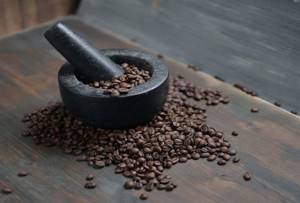
Mortar
Now about how to grind coffee with a pestle and mortar. The method is effective, but long. You'll have to make an effort. But you can grind the grains at any grinding level
Measure out the required amount of raw material and crush vigorously with a pestle. It will take 4-5 minutes.
To obtain fine particles, use a small amount of beans. If you use a lot, the grind will be coarser.
Small mortars will be able to grind coffee beans for just a couple of servings. But it will not be possible to achieve perfect uniformity. Therefore, the taste and aroma will not be fully revealed.
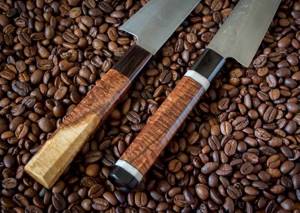
Manual grinding
Grain raw materials can be crushed with a knife. Place the beans on the board in a single layer and press down firmly with the blade.
Be prepared that chopping with a knife is a difficult method. It requires time and physical effort. Take a tool with the widest possible blade. Place the knife horizontally, with the sharp side facing away from you.
Interesting! Which milk is better for cappuccino?
More options
It is much easier to crush with a large stone. Wrap it in a clean, dry cloth and crush the beans using pressing movements.
Using a stone you can get particles of any size. The harder you press, the smaller they will be.
A garlic crusher is suitable for crushing. But this method is time-consuming. No more than 30 grains are placed in the crusher at a time. The resulting particles are of medium size.
You can use a metal bowl, plate, or other hard object with a flat side. The main thing is to carry out the procedure on a hard surface.

What to remember when using household appliances for purposes other than their intended purpose
Each kitchen device has a specific purpose - grinding, cutting, chopping. You can grind coffee beans without a coffee grinder using electric meat grinders, blenders, and food processors. But several important points cannot be ignored:
- Using household appliances for other purposes shortens the service life of the appliances.
- Parts of devices (knives, cutters) may become dull from exposure to hard grains.
- Equipment should be thoroughly washed before and after processing coffee beans to prevent the coffee from absorbing the flavor of the food.
If the equipment is used for a long time for other purposes, its knives may become deformed. As a one-time option, such grinding of grains is suitable, but you should not get carried away so as not to spoil expensive household appliances.
Tips for storing ground coffee
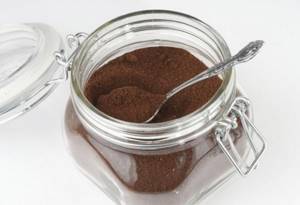
According to true gourmets, the most delicious and aromatic coffee comes from beans that are ground before preparing the drink. If you have a supply of ground coffee, it must be stored correctly so that the finished raw material does not lose its valuable properties, delicate aroma, and taste characteristics. Conditions for storing ground beans:
- sealed packaging;
- cool dark place;
- lack of heat, humidity;
- away from sunlight, light.
In ground form, coffee retains its properties for a week if stored in a tightly closed container or factory packaging. Once opened, raw materials lose their value within a day. The powder quickly absorbs moisture, which destroys the taste and aroma of the beans. It is best to store ground coffee in an airtight container in a kitchen cabinet with opaque doors, but not on the top shelf.
Subtle aroma, invigorating taste, rich strength - this is coffee, the favorite drink of millions of people. Different varieties, manufacturers, and grinding fractions create a wide choice for preparing the drink. The most delicious coffee is made from freshly ground beans. And if you don’t have a coffee grinder at hand, you can use kitchen appliances and accessories. Grinding beans with a blender, meat grinder, rolling pin and other methods does not in any way affect the taste characteristics of the coffee and the drink does not lose its strength and aroma.


